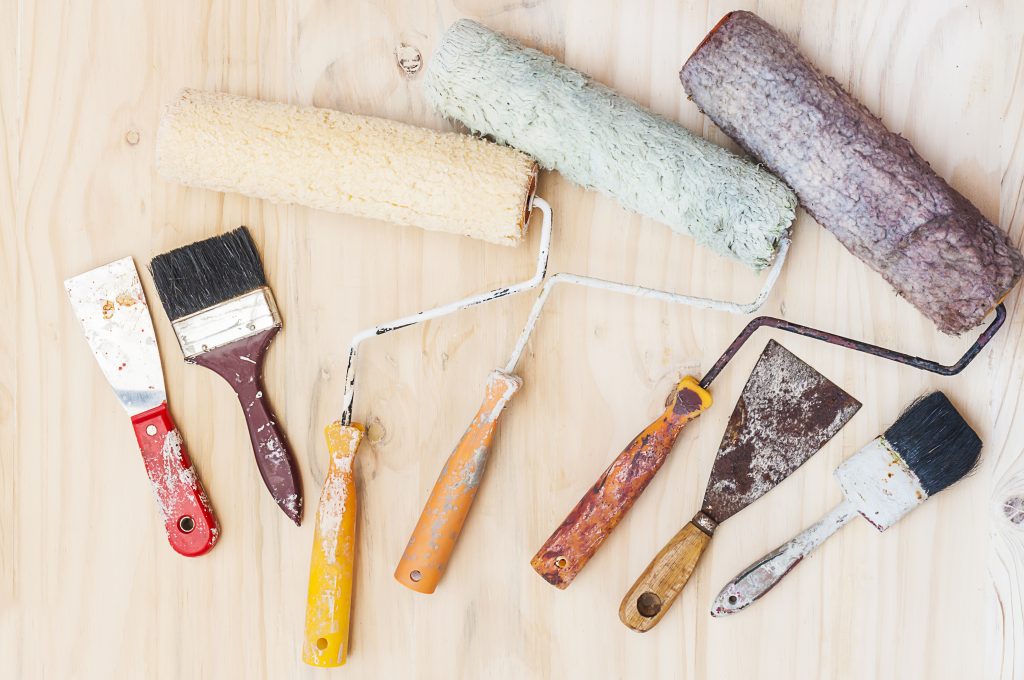How to Paint a Room Like a Professional

Painting a room can give any space a new look and feel. With the right tools and techniques, you can achieve a professional-quality finish.
This article will provide step-by-step instructions on how to paint a room like a professional, from preparing the space to troubleshooting common problems.
Two very important things to keep in mind before you get down to the process of painting are:
Invest in Quality Tools:
Acquiring high-quality painting tools is crucial for achieving a professional-grade finish. You will need a variety of painting supplies, including brushes, rollers, painter's tape, drop cloths, and more.
Here are some of the essential painting tools you will need:
- Paint brushes: There are many different types of paint brushes available, each with its own purpose. For example, a trim brush is used for painting edges and corners, while a roller is used for painting large areas.
- Paint rollers: Paint rollers come in a variety of nap sizes, which refers to the length of the fibers. A shorter nap is used for smooth surfaces, while a longer nap is used for rough surfaces.
- Painter's tape: Painter's tape is used to create clean lines between different colors of paint. It is also used to protect areas that you do not want to get paint on, such as windows and trim.
- Drop cloths: Drop cloths are used to protect the floor and furniture from paint spills. They are also used to create a work area that is free of debris.
- Other tools: Other tools that may be helpful include stir sticks, paint trays, and safety glasses.
By investing in quality painting tools, you can achieve a professional-looking finish that will last for years to come.
Don't Skimp on Prepping:
Preparing the space is essential for achieving a professional-grade finish when painting. This includes removing any switch plates and outlet covers, covering the floor and unmovable items, masking or removing the trim, patching any holes or cracks in the walls, and cleaning the walls thoroughly before painting.
Here are some specific steps you can take to prepare the space:
- Remove any switch plates and outlet covers. This will allow you to paint behind them and prevent paint from getting into the electrical sockets.
- Cover the floor and unmovable items. This will protect them from paint spills. You can use drop cloths, plastic sheeting, or old newspapers.
- Mask or remove the trim. If you are painting the walls a different color than the trim, you will need to mask the trim to prevent the paint from bleeding over. You can use painter's tape or plastic sheeting.
- Patch any holes or cracks in the walls. This will help the paint to adhere better and create a more even finish. You can use spackle or joint compound to patch the holes.
- Clean the walls thoroughly. This will remove any dirt, dust, or grease that could prevent the paint from adhering properly. You can use a mild soap and water solution to clean the walls.
By following these steps, you can ensure that your painting project is a success.
What You'll Need
To paint a room like a professional, you'll need a variety of tools and materials to kickstart the process. To start the process, you will need the following materials: paint (in your desired color and finish), paint brushes (in different sizes), a paint roller and roller cover, painter's tape, a drop cloth or old sheets to protect your floor and furniture, a paint tray, stir sticks, and a ladder or step stool (if needed).
Broadly, the things one requires can be divided into two categories: Tools and Materials. The following tables will give a clear idea about things needed to paint a room.
Equipment / Tools used for Painting a Room

When it comes to painting a room, having the right equipment and tools is crucial. This includes a high-quality paintbrush, roller, painter's tape, drop cloths, and more. Make sure you have all of the necessary tools before you start painting.
High quality Painting Tools you need before you start painting the room:
| Painting Tool | Uses | Click to buy |
| Paint Roller | Painting large & flat surfaces | Buy now |
| Paint Brush | Painting areas that cannot be reached by rollers | Buy now |
| Paint Mixer | To stir paint and prevent lumps | Buy now |
| Paint Tray | Holding Paint during painting | Buy now |
| Extension Pole | Used to reach & paint high, hard-to-reach places | Buy now |
| Abrasive Sandpaper | Smoothing out rough surfaces before Painting | Buy now |
| Angled Paint Brush | Used for painting in edges and tight spaces | Buy now |
Materials used in Painting a Room

Choosing the right materials is important for achieving a professional-looking finish. When selecting paint, choose a high-quality paint that is designed for the specific surface you are painting. You should also choose the right primer, as well as any necessary cleaning products or solvents.
| Painting Material | Click to buy |
| Exterior Paint | Buy now |
| Interior Wall Painting | Buy now |
| Primer & Sealer | Buy now |
| Filler | Buy now |
| Spray Paint | Buy now |
| Protective Paint | Buy now |
Instructions: How to Paint a Room like a Professional
Painting a room can be a daunting task, but with the right approach, it can be a fun and rewarding experience! With a little bit of patience, creativity, and attention to detail, you can transform your space into a masterpiece that even a professional would envy. Let's grab our brushes and get ready to unleash our inner artist!
To paint a room like a professional, follow these step-by-step instructions:
Remove and Prep Switch Plates and Outlet Covers
Before you begin painting, it's important to remove any switch plates and outlet covers from the walls. This will make it easier to paint around them and ensure a clean finish. Use a screwdriver to remove the covers, taking care not to damage the electrical wiring behind them.
Once the switch plates and outlet covers have been removed, use painter's tape to cover the exposed outlets and switches. This will protect them from getting paint on them while you're painting.
Cover Floor and Unmovable Items
Paint can be messy, so it's important to cover the floor and any unmovable items in the room before you begin painting.
Use drop cloths or plastic sheeting to cover the floor and any furniture or other items that can't be moved. This will help protect them from any paint drips or spills.
Mask or Remove the Trim
If you're planning to keep the existing trim in the room, use painter's tape to mask it off before you start painting. This will help ensure a clean, professional finish and prevent paint from getting on the trim.
If you're planning to replace the trim, you can remove it entirely before painting. This will make it easier to paint the walls and ensure a clean finish when you install the new trim.
Patch the Walls
When painting a wall, it is important to patch any holes or cracks in the walls first. This will help the paint to adhere better and create a more even finish.
To patch a hole or crack in a wall, you will need:
- Spackling paste
- Sandpaper
- A putty knife
- A damp cloth
Here are the steps involved:
- Clean the area around the hole or crack with a damp cloth.
- Apply a thin layer of spackle paste to the hole or crack, using the putty knife to smooth it out.
- Allow the spackle paste to dry completely.
- Sand the spackle paste smooth.
- Repeat steps 2-4 if necessary to achieve a smooth surface.
Once the hole or crack is patched, you can start painting the wall.
Here are some additional tips for patching holes and cracks in walls:
- Use a spackling paste that is designed for the type of hole or crack you are patching.
- Apply the spackle paste in thin layers, allowing each layer to dry completely before applying the next.
- Sand the spackle paste smooth before painting.
- If the hole or crack is large, you may need to use joint compound instead of spackle paste.
By following these steps, you can ensure that your wall repairs are done properly and that your paint job will look its best.
Clean the Walls
Before you start painting, it's important to clean the walls thoroughly.
Use a damp cloth to wipe down the walls and remove any dirt or debris that could interfere with the paint's adhesion. This will ensure that the paint adheres properly to the walls and help prevent any peeling or flaking in the future.
Prime the Walls
Using a primer is an important step in achieving a professional-looking finish when painting a room. A primer will create a smooth surface for painting and help ensure that the paint adheres properly.
Apply the primer to the walls using a paint roller, taking care to cover the entire surface evenly. Allow the primer to dry completely before moving on to the next step.
Cut-in the Edges
Cutting in the edges of the room is an important step in achieving a professional-looking finish.
Use a paintbrush to carefully paint around the edges of the room, including around the trim, corners, and ceiling. This will ensure that the final finish looks even and that there are no areas where the paint has bled over onto other surfaces.
Prepare Roller With Paint
Before you start painting the walls, you'll need to prepare the roller with paint.
Pour the paint into a paint tray, and use a roller to saturate it evenly. Be sure to remove any excess paint from the roller before painting. This will help prevent drips and ensure a smooth finish.
Roll in a W Shape
When painting the walls, use a roller to paint in a W shape. This will help ensure that the paint is applied evenly and that there are no streaks or lines.
Start at the top of the wall and work your way down, using long, even strokes to apply the paint. Be sure to overlap each section slightly to create a smooth finish.
Fill in and Complete
Once the walls are covered in paint, use a brush to fill in any areas that were missed. Take your time and be thorough, ensuring that the final finish looks even and professional. Then, let the paint dry completely before removing the painter's tape and switch plates.
By following these steps, you'll be able to paint a room like a professional and achieve a beautiful, even finish. Remember to take your time, do not rush, follow the instructions carefully, and use high-quality tools and materials for the best results.
Troubleshooting Common Painting Issues, such as Drips or Uneven Coverage
Even when you follow all of the proper techniques and use high-quality tools and materials, problems can still occur during the painting process.
Here are some common issues that you may encounter and tips for fixing them:
- Drips: If you notice drips or runs in the paint, use a brush or roller to smooth them out immediately. If the drip has already dried, use sandpaper to smooth it out and then touch up the area with paint.
- Uneven Coverage: If the paint looks uneven or patchy, it may be due to using too little paint or not applying it evenly. Apply a second coat of paint to ensure even coverage.
- Paint Peeling or Flaking: If the paint starts to peel or flake, it may be due to improper prep work or using low-quality paint. Sand the affected area and apply a new coat of high-quality paint.
Drying Time
After you've finished painting the room, it's important to allow sufficient time for the paint to dry. This will help ensure that the final finish looks even and that the paint adheres properly. The drying time will vary depending on the type of paint and the temperature and humidity in the room. Be sure to check the paint can for drying time recommendations.
Drying time after painting a wall is important for several reasons.
First, it allows the paint to fully adhere to the surface, preventing smudging or peeling.
Second, it allows time for any fumes or odors from the paint to dissipate, improving indoor air quality.
Additionally, proper drying time ensures that the surface is ready for any additional coats of paint or for use, such as hanging pictures or placing furniture against the wall.
The recommended drying time depends on the type and brand of paint used, as well as the humidity and temperature of the environment.
Conclusion
Achieving a professional-quality room painting requires dedication, precision, and time. However, with the appropriate tools and methods, anyone can attain an exquisite result. By adhering to these sequential guidelines and addressing common issues effectively, you can swiftly master the art of room painting. It's essential to emphasize the importance of investing in top-notch tools and materials, meticulous room preparation, and allowing adequate drying time for optimal outcomes. With perseverance and practice, you'll soon have the ability to rejuvenate any space with a flawless paint job.
FAQs
Do professional painters wash walls before painting?
What should be painted first in a room?
How many coats of paint do you put on a wall?
What is the correct order to paint a room?
i) Start with the ceiling
ii) Paint the walls
iii) Paint any trim or other details in the room




